Sibiu
Known in German as Hermannstadt, or in Hungarian as Nagyszeben, the city of Sibiu is one of the most important economic  Situated between the Fagaras and cultural centres in the South of Transylvania.
Situated between the Fagaras and cultural centres in the South of Transylvania.
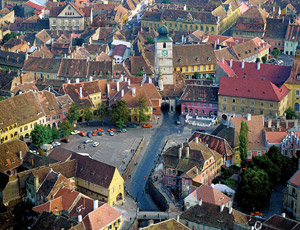
Cindrel and Lotrului Mountains, Sibiu is set in the Cibin Depression; the river with the same name (Cibin) runs through this depression, name that was taken over from the Latin name of the city, which was Cibiniensis / Cibinium. The northern and eastern limits of Sibiu are formed by the Târnavelor Plateau, which descends to the Cibin Valley through Guşteriţei Hill.
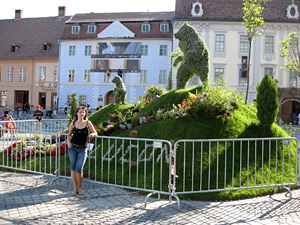
The first documentary attestation of the city, named Cibinium, dates from 1192, in a document from Vatican. In other documents from 1223 it is mentioned as Hermannstadt, or even as Villa Hermanni. It is certain that the city was founded by Saxon settlers from the Rin – Mosela area, on the place of an older settlement, possibly Slav, in the second half of the 12th century. Although it was attacked, conquered and almost destroyed in 1241 by the Mongolian hordes, the city rose again.
Thanks to its economic development, Sibiu was declared a city in the 14th century. In fact, it was one of the most important German citadels in Transylvania, being organized in 19 guilds.

Later, in 1692, thanks to the Austrian influence, Sibiu became the centre of Transylvania, in a time when the city knew an extraordinary economic and cultural development. Brukental Palace was built during that period. Then, in the 19th century there was built the first railway, and in 1897 it became the first electrified town in Romania. Unfortunately, during the World War II and the period after it, the communist government determined the emigration of most of the city’s ethnic Saxon in Germany. After the events on December 1989 Sibiu was declared a martyr city. In the 90s it gradually knew the cultural and economic rebirth, nowadays being in the top of the towns with the greatest foreign investments in Romania. Sibiu was designated European Capital of Culture for the year 2007 together with Luxembourg.

Tourist attractions
Known as a reference tourist centre, Sibiu distinguishes itself because the old city, surrounded by the walls of the old fortress, is like a nucleus for the entire city. Because of its geographic position, it is also divided into the “Upper City” (Orasul de Sus) (432 meters above the sea level) and the “Lower City” (Orasul de Jos) (415 meters above the sea level).

The Large Square
The Large Square (Piata Mare), also known as The Large Ring (Ringul cel Mare), is 142 meters long and 93 meters wide, and represents the historic centre of the city. At the beginning of the 15th century, it is mentioned as a cereals market, and then is known as a place for different feast and festivities. The Saxons also called it Der Grosse Ring or Grosser Platz, and in the interwar period it was named King Ferdinand Square. The craftsmen organized here rustic feasts, with beef and mutton barbecue, with excellent wines, taken out of huge barrels, with music and dance for all the inhabitants of the citadel. The meetings of the guilds, when they had to prepare themselves for the defending of the citadel, also took place here, and until the end of the 17th century the ones who had broken the law were executed here, in the open, as well. The South side of the square is considered an architectural monument because of its medieval style, unique in the area. In 2006 the square was paved with cubic stones, and an old grating fountain was placed here as well.
{tours-banner-scroll}

The Towers
Placed between the The Large Square and the The Small Square, The Council Tower(Turnul Sfatului), finished in 1588, is one of the most famous monuments in Sibiu. During its construction, the tower broke down, killing the painter Iohan David who was working at the adornment of the vault. It seems that only the first and second floor were kept from that construction, the rest of it was built during the next years. Now it has seven floors, the first parts being marked by openings that remind us of the old ramparts.
The Stairs Tower (Turnul Scarilor) is a solid construction, made of brick, one storied, with a vaulted passage at the first floor. Through here one can reach the stairs that link the Upper City and the Lower City.
The Goldsmiths Stairs Tower (Turnul Scarii Aurarilor) is a construction with two floors and an attic, and one can reach the stairs that lead to The Goldsmiths Square through its vaulted passage. Nowadays its both floors are fit to habitation.

The Gate Tower (Turnul de poarta), situated at the junction of the Passage of the Stairs and Odobescu Streets, represents the entrance in the town, keeping an aspect very similar to the initial one.
The Carpenters’ Tower ( Turnul Dulgherilor) is a tower with a military architecture, adapted to the fire guns, which was built in the 15th century.
The Potters’ Tower (Turnul Olarilor) was built in the 16th century and is united with the next tower by a rampart wall, a commonly used system in the area.
The Arquebusiers’ Tower (Turnul Archebuzierilor), having ramparts and throwing holes, is placed in the South side of the city, with an almost exterior position compared to the wall of the citadel. Turnul Pielarilor (the Tanners’ Tower) and Turnul Pulberariei (the Powder Tower) should also be mentioned.
{banner-sibiuen}

“Brukental” Museum
“Brukental” Museum, officially opened to the public in 1817, is housed by Brukental Palace, built between 1778 and 1788 by the baron Samuel von Brukental.
The History Museum, the Pharmacy Museum, the Natural History Museum and the Museum of Arms and Hunting Trophies are also located inside the palace.
The first two floors of the palace house art works included in the National Art Gallery, like paintings, graphics or sculptures from the 15th to 19th centuries, signed by Nicolae Grigorescu, Stefan Luchian, Nicolae Tonitza, Theodor Aman, Ion Andreescu, Theodor Pallady or Iosif Iser.

Brukental Library also has around 300 000 works consisting of manuscripts, foreign books, old Romanian books, specialized magazines and modern works. The first collections exposed here belonged to Baron Samuel von Brukental, Governor of Transylvania between 1777 and 1787. According to the documents of the time, the galleries were ready to receive visitors as early as 1790 (three years before Louvre’s opening). The palace was built in the Baroque style after the plans of a Viennese architect.
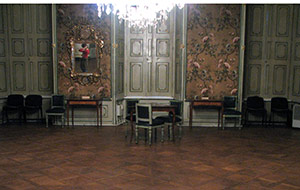
Visiting programme at Brukenthal Museum
Summer programme (21 March – 21 October):
Tuesday – Sunday: 10:00 AM – 6:00 PM
Monday and first Tuesday of every month: closed
Winter programme (21 October – 21 March):
Wednesday – Sunday: 10:00 AM – 6:00 PM
Monday and Tuesday: closed
Tickets price at Brukenthal Museum

The ASTRA Traditional Folk Civilisation Museum
The ASTRA Traditional Folk Civilisation Museum, located 4 km far from town, on the Dumbrava Forest, was founded in 1963 as the Popular Technique Museum, is a 96 hectare museum and its exhibition circuit is 10 kilometres long.
In this perimeter the visitors can admire traditional houses, original dwellings, household equipments invented by the inhabitants of the village, traditional means of transport, and so on.
There is also a 3 hectare modern wood-sculpture exhibition, with works inspired by the life of the village.

On winter, visitors can also profit by a (long narrow) boat row, a carriage or sled drive. More than that, the inn inside the museum offers 53 accommodation units, and one can serve a traditional meal at the tavern.
Visitors can come every day, at every hour, and for the night there is a lighting spot system with special effects.
Between the 1st January 2009 and the 10th July 2009, The National Complex ASTRA was visited by more than 100000 persons, from the country or from abroad. As usual, the main attraction was the Outdoors Museum from Dumbrava Sibiului (almost 90% of the visitors went there). The events that were most successful to the public were “Noaptea Muzeelor” (The night of the museums), “Ziua Sugarului” (The day of the suckling), “Tarafuri si fanfare” Festival, but also the Resurrection Liturgy. It is hoped that this year, the museum will be visited by 200000 people. Last year, there were 191806 visitors, in 2007 there were 270000 visitors and 130067 in 2006.

The visiting programme of the museums:
Tuesday - Sunday, 10:00 AM – 6:00 PM - “Franz Binder” Museum of Universal Ethnography, Casa Hermes, Piata Mica nr. 11; “Emil Sigerus” Museum of Saxon Ethnography and Folk Art (Piata Huet nr. 12 si Casa Artelor, Piata Mica nr. 21)
The Open Air Museum in Dumbrava SIBIULUI:
Monday - Sunday, 10:00 AM – 6:00 PM
Monday – Free entry (no interior visit)
Contact the ASTRA Traditional Folk Civilisation Museum
Address: 550182 Sibiu, Piata Mica, nr. 11
Tel: +40 (269) 218195 | Fax: +40 (269) 218060
E-mail: office@muzeulastra.ro
Web: www.muzeulastra.ro

The Evangelical Church
The Evangelical Church, or Evangelische Stadtpfarrkirche, was built in 1520, on the place of an old Roman basilica and is considered one of the most beautiful Gothic buildings in Transylvania. The statue of Bishop Georg Daniel Teutsch (1817 – 1893), known as an advocate of the autonomy of the Saxon community in Transylvania, is in front of the church.
The Cathedral Tower, a 7 storied building, is 73.34 meters high, being one of the highest towers in the area. In 1914 an organ, considered to be the greatest organ in the South – East of Europe was installed in the church. Inside the church there is also a real treasure composed of gilded silver cult pots, made by some famous handicraftsmen from Sibiu.
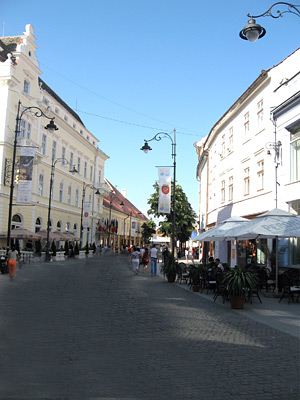
How to get there
Being one of the most important towns in Romania, there are many possibilities of getting there, by train, by plane or by car. The train is the cheapest way, although there are only two trains from Bucharest per a day. But there is a direct connection between Sibiu and Budapest – Vienna, and another route Bucharest – Sofia. An Intercity train connects Sibiu to Cluj.
Sibiu is located on two European routes, E 86 (Arad – Sibiu – Brasov) and E 81 (Cluj – Sibiu – Pitesti – Bucuresti).
There are also direct connections to important cities in Germany, France, Austria, the Republic of Moldova, Ukraine and Italy.
There are multiple possibilities for accommodation, in hotels, motels or boarding houses. Other attraction points are the winter resort Paltinis, 37 kilometres far from the centre of the city,  Balea glacial lake, about 100 kilometres far from town, and the Lacurile Sarate from Ocna Sibiului.
Balea glacial lake, about 100 kilometres far from town, and the Lacurile Sarate from Ocna Sibiului.
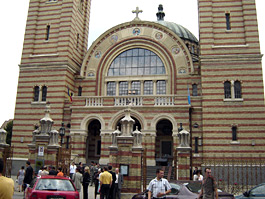
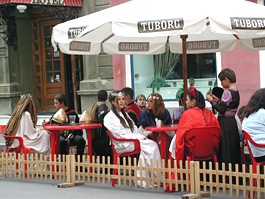

{adsgoogle300}









